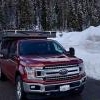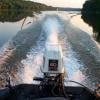Check out these two You Tube videos which talk about connecting solar panels together. You may need to cut and paste as I'm not sure that the hyperlinks work.
- DIY solar power with Will Browse
- Explorists Life - DIY campers
Will Prowse is excellent and is worth subscribing to as he does a lot of reviews on lithium batteries, etc.
What they basically say is that Parallel connected panels need to be the same voltage and series connected panels need to be the same amperage.
If you are going to use the splitter in the Amazon link above, you will need to get a panel which produces the same voltage as the one that is already on the roof as the splitter is wired in parallel.
Now with regards to the inputs on the back of the camper and on the roof, (and hopefully somebody will correct me if I'm wrong here) they must be wired in parallel otherwise there would be an open circuit when one of the outputs wasn't being used. In which case any panel that you connect to the rear input must be the same voltage as the panel on the roof.



















